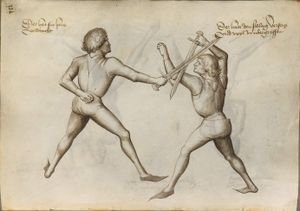Steve
Mostly Harmless
Are you equating pro wrestling with competition? Pro wrestling is much more like wushu.
Sent from my SPH-L710 using Tapatalk 2
Last edited by a moderator:
Follow along with the video below to see how to install our site as a web app on your home screen.
Note: This feature may not be available in some browsers.
1) Some arts are only for self defence, challenging someone to a fight or accepting a challenge is not self defence.
That arm wrap technique is taught in my art as well among others - interesting.
German medieval sword fighting of Hans Talhoffer. One of the Messer sequences (tafel 113):It's very common... Not really surprising at all, when you consider that the various arts are all answering similar questions involving the same body. What they do after the wrap may change (maybe an elbow, maybe a throw, maybe a knee, maybe all of the above) depending on their principles and tactics... and exactly how they get there may vary, but the root idea is similiar.



That arm wrap technique is taught in my art as well among others - interesting.
Sometime you just don't have any choice. When you run a commercial school, different people may walk into your school and challenge you. Some may challenge you in boxing rules (punch only), some may challenge you in MT rules (kick + punch), some may challenge you in Judo rules (wrestling only). If you take those challenges as opportunities to test your own skill against other styles, you will be happy to accept those challenges.
Is that "self defense"? To defend you commercial school from closing down is "self defense" by my definition.
Happened to Tyson:
http://www.deseretnews.com/article/15004/TYSON-BREAKS-RIGHT-HAND-IN-STREET-FIGHT.html?pg=all
"Tyson said he punched Green above the eye but damaged his own right hand in the process, causing a hairline fracture to the third metacarpal."
karate. The boxer gets constant hand conditioning either through the heavy bag, or sparring. They get added points since their art forces/teaches them to take punches.
Yet another benefit of competition and sport fighting.
Thats just one short demo man he does so much more.Yeah, if you noticed, he never directly punched the rock. Impressive conditioning though.
I seriously doubt many karate schools in the US are making their students slam their hands into rocks though.
Himura. My point is, that you need to train the high percentage maneuvers more often because they are the ones that set up the Illegal for competition low percentage maneuvers.
It is easier to perform that face rake(I assume that's what your talking about) if you can deal with this strikes and distract him with your own. One thing I don't understand about my new art of budo taijutsu is the lack of separating the striking and striking defense and getting lots of reps on them. So far I have seen no use of strike shields and focus mits. The striking and striking defense aspect is IMHO so very important to setting up everything else.
I whole heartedly agree with you regarding TMA and ground. I would expand what your saying with this. There needs to be a focus on the main positions. Guard/mount both bottom and top/ half guard and side guard. I think that tma that want to do something on the ground besides spaz out need to put in many repititons on escaping each of those situations. I would also put attention in to the escape bottom of mount with punch defense. Another thing, that I notice is, that many tma that fall prey to when they get taken down by a grappler is they end up on top, in guard then get pulled down, into the bottom guys armpits and then guillotined. They need to learn to avoid that, and learn basic submission defense from each position. Grapplers are more vulnerable when they are going for a submission. I think that, if they focus on those basic things, and actually put in a lot of time practicing it, more then a few minutes a week they would be ok.
They don't need 600+ techniques, but they do need to put in quality time on a the things I outlined above and they will do just fine. I just feel they don't do enough time dedicated to it. Heck bring in a BJJ guy and let your guys go to town on him. They will learn a lot.
This better for you?
There are plenty of Goju Guys that compete first of all I know several Goju guys that fight in MMA. 2nd hand condition isnt about punching holes through people. Your claim was Karate doesn't condition hands so boxers hands are stronger. Thats just not true. I dont care if you think Goju works or notYes, but the problem still remains; We have no way to test the effectiveness of these hand techs because Goju doesn't compete. We know how effective boxing techniques are, because boxers are utilizing punches in a competitive environment. We know that Bjj holds and locks work against resisting opponents because of competition. We know Judo can throw people because Judokas throw resisting opponents in competition. We know that high kicks in TKD and MT have knockout power because people have been knocked out with high kicks to the face in those sports.
All we have to show the effectiveness of Goju-Ryu is punching makiwara or rocks. If we got a Goju guy stepping into an NHB tournament and punching holes through people's chests and shrug off body blows because of their insane conditioning, I'd be a believer. Unfortunately we don't have that because Goju practitioners refuse to test their skills in an arena.
Himura, you mentioned that the defeated opponents tried to fight gracies way. My question is, what if a art is a close range standing grappling heavy art like Hapkido or budo taijutsu(at least from what I have done so far it seams that way)? Arts like that, in their strongest area are in the gracies as well. It could be argued though that the hapkidoan could just stay at range and kick him and keep back peddling but, then that wouldn't be Hapkido that would be TKD. Edit to add. I mentioned Hapkido because in one Gracie challenge video the poor guy tries 3 times and it just gets worse and worse. He even tries to grab Roylers jewels during one exchange and still didn't work.
So what is your opinion on that. What if your art, is at its strongest, up close and that is exactly were the gracies wanted it??
There are plenty of Goju Guys that compete first of all I know several Goju guys that fight in MMA. 2nd hand condition isnt about punching holes through people. Your claim was Karate doesn't condition hands so boxers hands are stronger. Thats just not true. I dont care if you think Goju works or not
All of which were legal in UFC 1-6 and none of which worked.. Case in point. The HKD guy in the challenge videos, he kept trying to sack grab, and guess what, didn't work.. Plenty of hair pulling, fish hooking and other crap on the list in UFC 1-6 NONE OF THEM WORKED.
I don't know how you think I said you needed to submit someone on the ground. I was mainly talking about learning and being comfortable in those main positions as if you get taken down in a real fight, your going to end up in one or more of those. Learning how to stop a submission attempt(Which can be a joint break, I don't have to sub you. I can break you.) is easy. Being able to get out of that situation, in those common places to get trapped in is paramount.
As to the spazzing out part. Unless your comfortable actually fighting on the ground, most people spaz the first few times. I know I did coming from boxing, as did the TKD black belt that I pwnt in mma rules sparring..(Which felt so good when it happened. I was so proud) Again there are plenty of videos of people spazzing.
The purpose of this thread and subsequent question, stemmed from that other thread, "Can BJJ work in a real fight?". It seemed to me anyways, that the notion that sport fighting was superior to the TMAs, because of their training methods. I simply asked if the TMAs would be better if less time was spent on working kata and empty hand SD techs, and more time on the fighting aspect, such as we see with sport fighting. I mean, we don't see MMA fighters doing kata or working on knife defense, we see them working striking, hitting the pads, sparring, grappling, etc. Since at least one person in that other thread gives the impression (despite what he claims) that the sporting methods are superior, I simply wanted to hear from the members, and what they thought.I hope that made sense.
...
So, in your opinion, do you feel its a waste of time, for the TMA student to spend time learning defenses to various attacks, ie: grabs, kicks, weapons, etc.?
